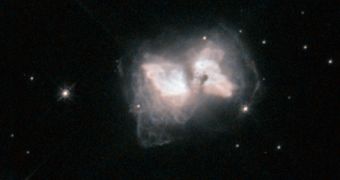Astronomers operating the NASA/ESA Hubble Space Telescope were recently able to capture this amazing new image of a cosmic butterfly called Roberts 22, or AFGL 4014. This object is a nebula that is only now forming from materials released by a dying star at its center. The object is located relatively close to Earth, allowing for detailed observations and monitoring.
Nebulae such as this one form when a massive star reaches the end of its burning cycle and begins to shed the outer layers of its atmosphere. This happens because the amount of fuel it contains is no longer able to sustain constant nuclear fusion. The forces keeping the star together start to fall out of balance with the one trying to rip it apart, so the stellar atmosphere is the first to go.
In this Hubble image, Roberts 22 reveals a very intricate structure, with overlapping loops and filaments working together to create a complex arrangement. These interference patterns will only grow more accentuated in time, as more and more material is ejected from the dying star. Astronomers classify this structure as a pre-planetary-stage nebula,
The object will turn into a fully-fledged planetary nebula as soon as the star at the core of the object becomes hot enough to ionize the gas that it is currently releasing into space. This shedding process began roughly 400 years ago and is likely to continue for at least a few more centuries. The pre-planetary stage in a nebula's life is short-lived, especially compared to its parent star's main sequence.

 14 DAY TRIAL //
14 DAY TRIAL //